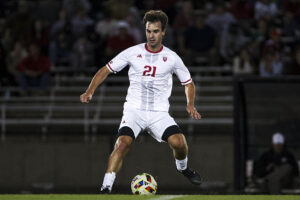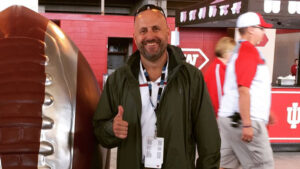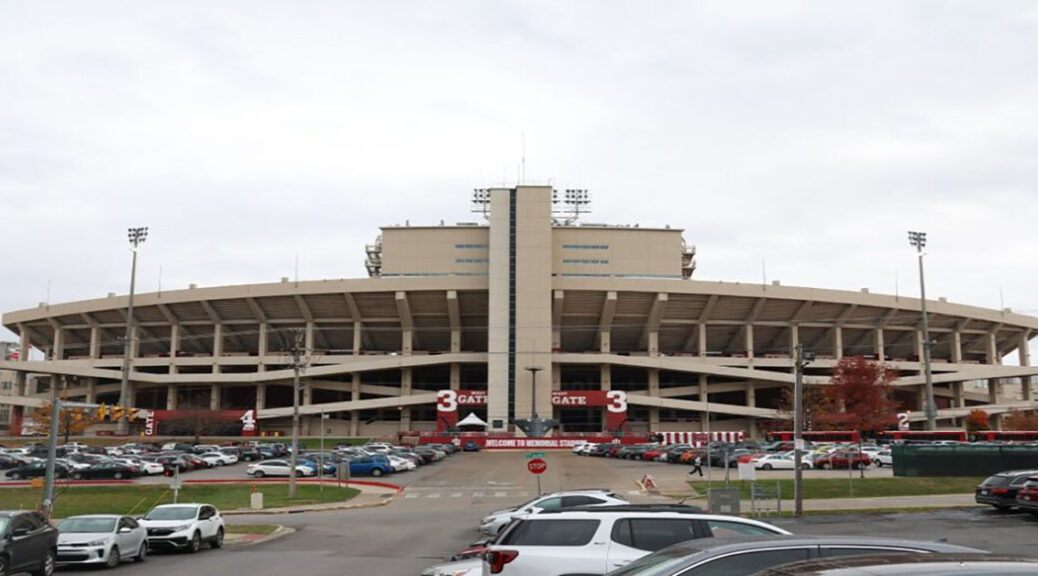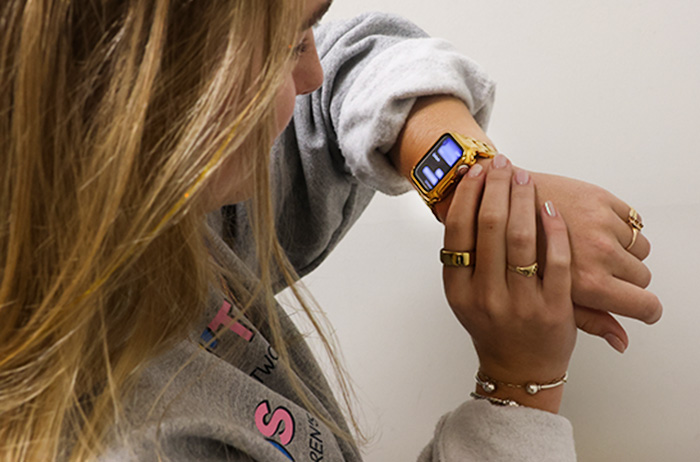NIL Generates Competition Between Sports and Crumbles Team Dynamics at Indiana University
By Adelyn Rabbitt, Maddie Greenberg and Nicole Dettmer
BLOOMINGTON, IN (Nov. 5, 2024)
Under bright fluorescent flood lights, the Indiana University men’s soccer team gathered to smile for a group picture after defeating Northwestern. Junior Jack Wagoner grinned along with his teammates as they celebrated the 6-1 win, which earned them their share of the Big Ten regular season title. This was monumental for the team, as it clinched their near-perfect October record.
As the crowd cheered, photos were taken by media personnel covering the big win. Media has played a huge part in college athletics ever since the Supreme Court ruled against the National Collegiate Athletic Association’s (NCAA) attempt to limit education-related payments to student athletes. This ruling became known as name, image and likeness, or NIL. The ruling went into effect on July 1, 2021, and allowed college athletes to use their public name, image and likeness to gain sponsorships and increase their financial gain from their sport. Deciding whether or not to implement NIL is a choice given to colleges, meaning some colleges have no NIL rules while others have widespread NIL rules. Though most athletes seemed to appreciate the ruling, controversy quickly arose with claims of the ruling’s unfairness and inequality.

A third-year law student and J.D. candidate well-versed in NIL, Amelia Taylor, explained how NIL works. “The law basically says the NCAA can’t require or stop student athletes from doing something that is not for the purpose of the NCAA,” Taylor said. This means the NCAA cannot control the name, image and likeness of individual players. The NIL ruling gives student athletes the legal right to use their image in the media for financial gain. As for public controversy, Taylor said, “Even since this started, there’s been just as much backlash as public optimism about it.”
IU heavily implements NIL rules. Men’s basketball and football are the most popular sports overall at IU, and the athletes’ pay shows that. In less popularized sports, such as men’s soccer or any women’s sport, the pay is generally lower. This is often because less popular sports get less television time, making them much less likely to be spotted by brands. Additionally, more popular players on a team receive better NIL deals than less well-known players. Jack Wagoner, an IU men’s soccer player, commented on NIL, expressing his support for the ruling. “I believe it is the right way to handle paying college athletes,” Wagoner wrote in an email.

Though men’s soccer NIL deals are commonly much less financially fulfilling than the NIL deals of more popularized sports, NIL still provides beneficial finances to many athletes. Wagoner has a few NIL deals, including one called ‘Hoosiers for Good’ and other local partnerships. Wagoner highlighted his appreciation for local NIL partnerships, including the example of athletes receiving deals from Everbowl, a popular acai bowl shop on Kirkwood, in return for promoting Everbowl on social media. “These mean much more to me than just being paid upfront,” Wagoner wrote. “I feel like I am more effectively giving back to the community around me.” Wagoner is aware that he is paid less than other male athletes at IU, and he highlighted IU men’s soccer and swimming in his response. “Both programs have a very rich history and are the powerhouses in their relative sports, so deserve to have more NIL opportunities,” Wagoner wrote. However, Wagoner understands that basketball and football are more central in media coverage and therefore thinks NIL is fair, as many players have built their success and image throughout the years.

Opposingly, other student athletes do not share the same sentiments. Jeremy Gray, IU Athletic Director, commented on the unseen NIL disparities between IU student athletes in an online press conference. Gray said sports psychologists have seen mental health struggles in IU student athletes skyrocket post-NIL ruling as the players scramble to acquire the same deals as their teammates. “Teaching them how to accentuate their own brand is really really important,” Gray said. Regarding teammate relationships, Gray said NIL can “change the dynamic” between teammates, as NIL has turned finances into a competitive playing field. Taylor also expressed the sentiment of changed dynamics due to the NIL ruling. “The issue was… is it going to ruin teamwork and ruin locker room situations and dynamics because now a player is mad that their teammate is making much more money but not doing anything different?” said Taylor.
When NIL began, it became clear that the ruling was unfair to women. Though women’s pay was already unequal to men’s pay, NIL showed that women’s sports are often less popularized than men’s sports. “This (NIL) is just going to continue making the disparity between especially gender even wider,” Taylor said. Taylor brought up the struggles less popular teams are having with recruiting athletes as a result of NIL, saying the teams could cease to exist as a result of the athletes’ pay disparities between schools. Of course, there are exceptions to this. IU women’s basketball players are likely to make much more money than men’s soccer or tennis players due to basketball being more popularized than soccer or tennis. However, within specific sports, such as basketball or soccer, men are paid more. There are athletes like Caitlin Clark who take the media by storm and end up landing NIL deals that are more than some men’s deals within the same sport, but it is extremely uncommon.
People walking on Kirkwood comment on their perception of NIL. The topic of NIL is generally well-known by IU students and residents of Bloomington.





